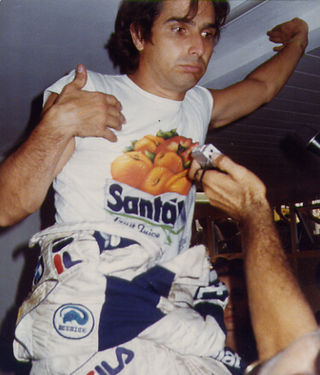Scuderia Ferrari S.p.A. is the racing division of luxury Italian auto manufacturer Ferrari and the racing team that competes in Formula One racing. The team is also known by the nickname "The Prancing Horse", in reference to their logo. It is the oldest surviving and most successful Formula One team, having competed in every world championship since the 1950 Formula One season. The team was founded by Enzo Ferrari, initially to race cars produced by Alfa Romeo. By 1947 Ferrari had begun building its own cars. Among its important achievements outside Formula One are winning the World Sportscar Championship, 24 Hours of Le Mans, 24 Hours of Spa, 24 Hours of Daytona, 12 Hours of Sebring, Bathurst 12 Hour, races for Grand tourer cars and racing on road courses of the Targa Florio, the Mille Miglia and the Carrera Panamericana. The team is also known for its passionate support base, known as the tifosi. The Italian Grand Prix at Monza is regarded as the team's home race.

Edward McKayCheever Jr. is an American former racing driver who raced for almost 30 years in Formula One, sports cars, CART, and the Indy Racing League. Cheever participated in 143 Formula One World Championship races and started 132, more than any other American, driving for nine different teams from 1978 through 1989. In 1996, he formed his own IRL team, Team Cheever, and won the 1998 Indianapolis 500 as both owner and driver. The team later competed in sports cars.

The 1984 Italian Grand Prix was a Formula One motor race held at Monza on 9 September 1984. It was the fourteenth race of the 1984 Formula One World Championship.

The 1981 FIA Formula One World Championship was the 35th season of FIA Formula One motor racing. It featured the 1981 Formula One World Championship for Drivers and the 1981 Formula One World Championship for Constructors, which were contested concurrently over a fifteen-race series that commenced on 15 March and ended on 17 October. Formula One cars also competed in the 1981 South African Grand Prix, although this was a Formula Libre race and was not part of the Formula One World Championship.
Osella is an Italian racing car manufacturer and former Formula One team. They participated in 132 Grands Prix between 1980 and 1990. They achieved two points finishes and scored five world championship points.

Gabriele Tarquini is an Italian former racing driver. He participated in 78 Formula One Grands Prix, debuting on May 3, 1987. He scored a single championship point, and holds the record for the most failed attempts to qualify. He has subsequently raced successfully in Touring Cars, winning the BTCC in 1994, the ETCC in 2003 the WTCC in 2009 and the WTCR in 2018.

Gianni Morbidelli is an Italian racing driver. He participated in 70 Formula One Grands Prix, debuting on 11 March 1990. He achieved one podium, and scored a total of 8.5 championship points. He currently competes in the TCR International Series.
Fondmetal S.p.A. is an Italian manufacturer of alloy wheels, founded in 1972 by Gabriele Rumi.

Forti Corse, commonly known as Forti, was an Italian motor racing team chiefly known for its brief and unsuccessful involvement in Formula One in the mid-1990s. It was established in the late 1970s and competed in lower formulae for two decades. The team's successes during this period included four Drivers' Championships in Italian Formula Three during the 1980s, and race wins in the International Formula 3000 championship, in which it competed from 1987 to 1994. From 1992, team co-founder Guido Forti developed a relationship with the wealthy Brazilian businessman Abílio dos Santos Diniz that gave Diniz's racing driver son, Pedro, a permanent seat in the team and the outfit a sufficiently high budget to consider entering Formula One.
Emanuele Naspetti is a racing driver and entrepreneur from Italy.
The European Touring Car Championship was an international touring car racing series organised by the FIA. It had two incarnations, the first one between 1963 and 1988, and the second between 2000 and 2004. In 2005 it was superseded by the World Touring Car Championship, and replaced by the European Touring Car Cup between 2005 and 2017 when became also defunct.

During its history, Alfa Romeo has competed successfully in many different categories of motorsport, including Grand Prix motor racing, Formula One, sportscar racing, touring car racing and rallies. They have competed both as a constructor and an engine supplier, via works entries and private entries. The first racing car was made in 1913, three years after the foundation of A.L.F.A., the 40/60 HP had 6-litre straight-4 engine. Alfa Romeo quickly gained a good name in motorsport and gave a sporty image to the whole marque.

The 1994 Auto Trader RAC British Touring Car Championship season was the 37th British Touring Car Championship (BTCC) season.
Italian motor manufacturer Alfa Romeo has participated many times in Formula One. It currently participates as Alfa Romeo F1 Team Stake while being operated by Sauber Motorsport AG. The brand has competed in motor racing as both a constructor and engine supplier sporadically between 1950 and 1987, and later as a commercial partner since 2015. The company's works drivers won the first two World Drivers' Championships in the pre-war Alfetta: Nino Farina in 1950 and Juan Manuel Fangio in 1951. Following these successes, Alfa Romeo withdrew from Formula One.
The 1996 International Touring Car Championship was the thirteenth season of premier German touring car championship and also only first and final season under the moniker of International Touring Car Championship. It was for FIA Class 1 Touring Cars and it was contested by Mercedes-Benz, Alfa Romeo and Opel. It was formed of the Deutsche Tourenwagen Meisterschaft series that ran both a short German & International-based series in 1995. These were fused together to form the International Touring Car Championship. The eventual champion was Manuel Reuter driving an Opel Calibra, and Opel won the manufacturer's championship.

The Dallara 3087 is a Formula 3000 car, first used in the 1987 International Formula 3000 season, with which the BMS Scuderia Italia team competed in the first race of the 1988 Formula One season. Driven by Alex Caffi, it failed to pass pre-qualifying with its fastest time being 18 seconds slower than the time set by Ayrton Senna for pole position. The BMS Scuderia Italia team replaced the car for the next race with Dallara F188 which was specifically designed for Formula One.

Tony Southgate is an English engineer and former racing car designer. He designed many successful cars, including Jaguar's Le Mans-winning XJR-9, and cars for almost every type of circuit racing. He was responsible for the chassis design of Ford's RS200 Group B rally car. Southgate was employed as chief designer or technical director for many Formula One teams for over twenty years. These teams included BRM, Shadow and Arrows. Southgate retired after producing the Audi R8C, which was a major influence in the Bentley Speed 8, which won Le Mans in 2003. He continues to be a regular visitor to current and historic race meetings.

Edward Mackay "Eddie" Cheever III is an Italian-American racing driver who competes in the FIA World Endurance Championship for MR Racing in the LMGTE Am class. He is the son of retired Formula One driver and 1998 Indianapolis 500 winner Eddie Cheever.

Antonio Maria Giovinazzi is an Italian racing driver who currently competes in the 2023 FIA World Endurance Championship driving for Ferrari – AF Corse and also serves as the reserve driver for Scuderia Ferrari, Haas and Alfa Romeo Racing in Formula One. He was the 2015 FIA Formula 3 European Championship runner-up and raced with Prema in the 2016 GP2 Series, again finishing runner-up with five wins and eight overall podiums. He made his competitive debut for Sauber at the 2017 Australian Grand Prix, replacing the injured Pascal Wehrlein. He also replaced Wehrlein at the following Chinese Grand Prix as Wehrlein continued his recovery. He raced full time for Alfa Romeo Racing from 2019 to 2021. During his tenure for Ferrari AF Corse, he won the 2023 24 Hours of Le Mans alongside James Calado and Alessandro Pier Guidi.
Vincenzo "Enzo" Osella is an Italian former racing driver and team owner. He is the founder and chairman of Italian auto manufacturer Osella. The team competed in Formula One between 1980 and 1990.











